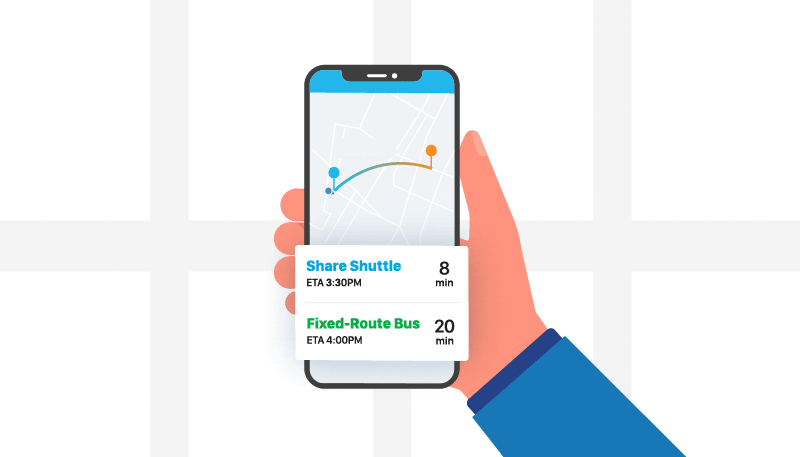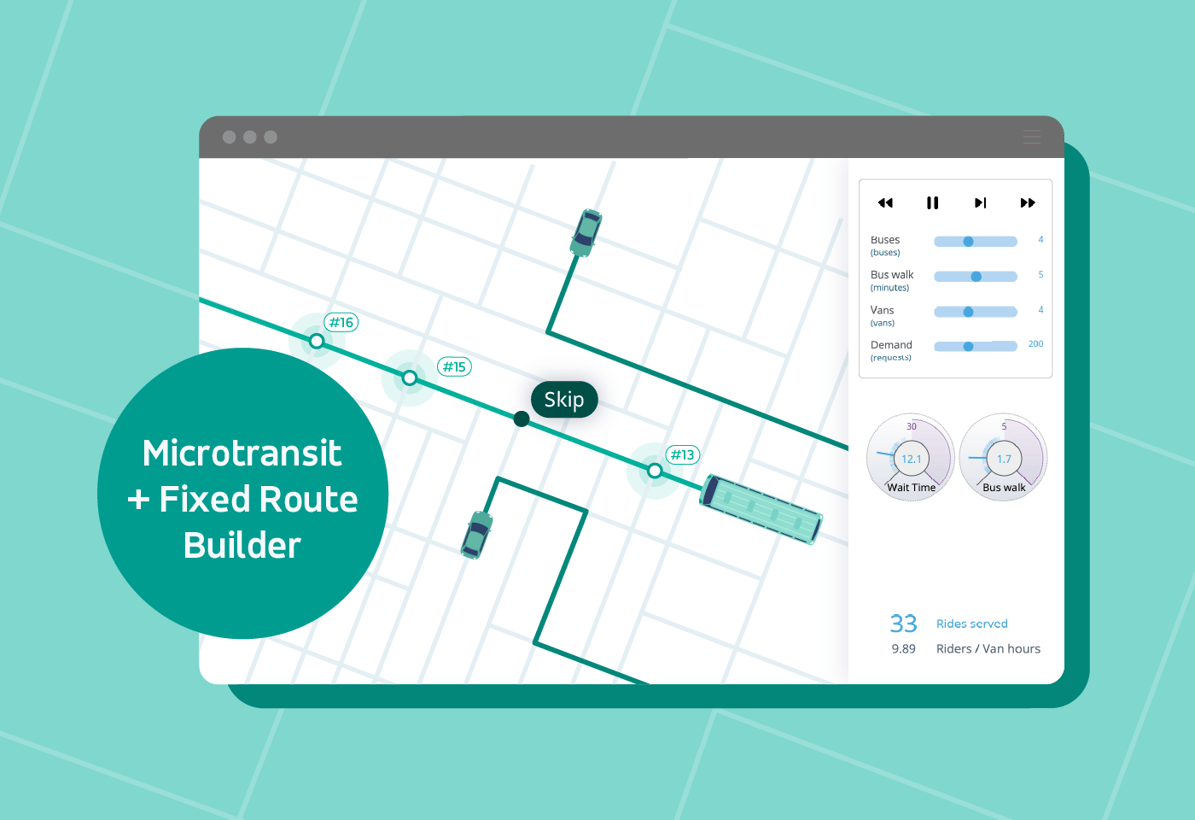First, some basics. Let's get started.
Ellie lives near a high-frequency bus route and wants to go to the grocery store, which is also on the bus route. She looks at the schedule, and the bus comes in five minutes. Easy! Ellie jumps on the bus and is grocery shopping in no time. But let’s be honest: Ellie’s ride was pretty unique. Not everyone lives a few steps from the most popular bus route in town. Moreover, Ellie travels to and from different places around town — it’s not always as simple as the ride to the grocery store. For most other trips, Ellie drives or hails a single-occupancy vehicle. But with an on-demand transportation network, Ellie could easily choose how to take mass transit anywhere in the city. Imagine two systems working together, automatically calculating which vehicle — an on-demand shuttle or a fixed-route bus — is best-suited to fulfill the trip request based on vehicle ETA, walking distance to the nearest bus stop, and other factors. Sam lives six blocks from the bus stop and wants to visit Ellie, who lives across town. He opens his transit app and calculates the route. With Sam’s office on a bus route, the app normally suggests taking the bus home from work. But the ride to Ellie’s place isn’t a straight shot, and even if it was, the next bus isn’t going to arrive for 20 minutes. A shared shuttle, however, is just eight minutes away, it can meet Sam a block from his apartment, and it’s carrying two other passengers headed in the same direction. The app suggests the shuttle, and Sam is rolling in no time.
But let’s be honest: Ellie’s ride was pretty unique. Not everyone lives a few steps from the most popular bus route in town. Moreover, Ellie travels to and from different places around town — it’s not always as simple as the ride to the grocery store. For most other trips, Ellie drives or hails a single-occupancy vehicle. But with an on-demand transportation network, Ellie could easily choose how to take mass transit anywhere in the city. Imagine two systems working together, automatically calculating which vehicle — an on-demand shuttle or a fixed-route bus — is best-suited to fulfill the trip request based on vehicle ETA, walking distance to the nearest bus stop, and other factors. Sam lives six blocks from the bus stop and wants to visit Ellie, who lives across town. He opens his transit app and calculates the route. With Sam’s office on a bus route, the app normally suggests taking the bus home from work. But the ride to Ellie’s place isn’t a straight shot, and even if it was, the next bus isn’t going to arrive for 20 minutes. A shared shuttle, however, is just eight minutes away, it can meet Sam a block from his apartment, and it’s carrying two other passengers headed in the same direction. The app suggests the shuttle, and Sam is rolling in no time.  Ta-da! More efficient rides. Sam avoids driving to Ellie’s or hailing a single-occupancy vehicle. Plus, with the algorithm suggesting the best route, trips are not unnecessarily duplicated, thereby minimizing traffic, maximizing resources, and increasing overall system efficiency.
Ta-da! More efficient rides. Sam avoids driving to Ellie’s or hailing a single-occupancy vehicle. Plus, with the algorithm suggesting the best route, trips are not unnecessarily duplicated, thereby minimizing traffic, maximizing resources, and increasing overall system efficiency.
Time to go big.
Now let’s see how combining on-demand technology with fixed routes can work together at scale. We created this transit toy model to let you play around with visualizing your own transit network. Integrated transit systems work well, because they take what’s working and, simply put, make the overall network run even better. Using the tool below, you can see what a basic network might look like if it maintained one popular train or bus route, and then added on-demand microtransit to the mix. Use the sliders below to see how the new on-demand service might perform at various supply and demand levels, with representative limits on detours, fleet sizes, and vehicle capacities. [via-sim-embed id="tool_2"]Your fleet, your rules.
- Buses: How many fixed route buses are in your public transportation network?
- Bus walk: How many minutes do you expect people to reasonably walk to a bus station? Passengers who are further away than your maximum walking distance will take an on-demand shuttle instead.
- Vans: How many on-demand vehicles are in your fleet?
- Demand: How many requests do you expect potential riders to make? Naturally, we want to be able to serve as many ride requests as possible.
So, how’d ya do?
Based on the choices you made when playing with the models, did you learn anything about how they affected the service? Here are a few things to consider:- Wait time: How long did passengers have to wait for a ride given the level of demand and number of vehicles in your fleet?
- Rides served: How many people who requested a ride were given an option that they accepted, and then completed?
- Utilization (rides per vehicle hour): How efficient was the use of vehicles in your new on-demand fleet?




